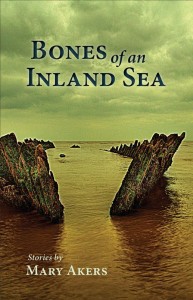
Press 53
210 pages, $17.95
Review by Carmen Maria Machado
The interwoven collection—the hybrid of the story collection and novel—has always been a fascinating genre. It takes elements from each parent—the satisfaction of novel-length exploration, the brilliant individual facets of the story collection—and turns it something entirely new, and, deployed properly, entirely gratifying. In the spirit of that genre comes Bones of an Inland Sea, the newest book from Mary Akers.
The linked stories in Bones progress in rough, but not exact chronological order, from the late 19th century to an unspecified dystopian future, telling first the story of a shipwrecked sea captain’s wife, and, last, that of a prisoner of a cult on a floating island. In between, we learn the intimate details of the lives of the many people that link them to one another across the intervening centuries. These bookending stories mirror each other, both following a woman lost among many, from whom love has been snatched away.
The collection is richly detailed and atmospheric: a pleasurable amalgamation of bodies and breath, water and sand, the burning heat of a mushroom cloud. The solid backbone running through the entire work is one of science (biology, anthropology, ecology, oceanic studies, and everything in between), reminiscent of the work of Andrea Barrett, who also explores the intersection of the sciences and women’s lives. The stories vacillate in location, clustering mostly in the Pacific Ocean and the Atlantic around southernmost Florida, but all take place somewhere where land—or something approximating it—touches sea.
I considered as I read what makes a connected collection more than just stories with overlapping characters. I realized that I’ve read linked stories where their order was more or less arbitrary, their placement interchangeable. In Bones of an Inland Sea, the individual pieces are laid out purposefully. The specific placement of each story is critical. Akers deploys details, names, and connections in a way that feels organic. The reader senses that they are looking at small details of a larger body—the book’s blurb suggests a similarity to coral, and I think the analogy is apt—and only when the collection is over and you step back do you understand its full shape. There is a great pleasure in figuring out how each story bears on the ones that preceded it.
Individually, many of these stories spark and crack with life. “Christmas in Phuket,” about the 2004 Sumatra–Andaman earthquake and resulting tsunami, vacillates between terror and sorrow, riding close to Leslie, a visiting scientist, while also laying out the scale of devastation (and, happily, avoiding the “faceless mass of foreigners” syndrome to which it might have fallen victim). In “Viewing Medusa,” a group of biologists, including Leslie’s daughter, are researching box jellies in Dominica. The story starts casually but is soon electrified by a horrific crime. You are yanked straight through, first by the characters and then by the suspense, and the story ends with a flawless chill. “Madame Trousseau,” told from inside Leslie’s mother’s mind, laid to waste by Alzheimer’s, is a pitch-perfect whirlwind of free association, moving the reader between the present and past in a way that feels real and heartbreaking. And the final story, “Waste Island,” about Leslie’s future granddaughter ensnared in a cult living on a floating island of trash, is unsettling and hopeful, the satisfying end of an arc that began so many generations before.
These successful stories, however, unfortunately highlight the weaknesses in the stories that don’t quite measure up. The eponymous “Bones of an Inland Sea” contains the timeworn plot of the ill-advised student-professor affair, told from the point of view of the former student and lover. While knowing this information is critical to several later tales, the story itself is like many others about the exact same topic, differentiated only by the rigorousness of its scientific content. The majority of “Who Owns the Moon?” is a letter from the protagonist’s grandfather to her childhood self, but the letter seems less like an authentic found document and more like a switched POV, a fact that is surprisingly distracting. Other stories, “House of Refuge” in particular, build and build in tension but stumble at the last moment, missing beats or deflating without warning.
But despite its structural faults, Bones of an Inland Sea ultimately succeeds. Akers has a good eye for character, setting, and detail, and a steady hand on her lush prose. It may be an uneven collection, but its ambition and scope do wonders for the overall reading experience. I look forward to her future projects—to whatever strange shore they may lead.
***
Carmen Maria Machado is a fiction writer, critic, and essayist whose work has appeared or is forthcoming in The New Yorker, AGNI, The Paris Review, The American Reader, Tin House’s Open Bar, Los Angeles Review of Books, and many other publications. She is a graduate of the Iowa Writers’ Workshop, and lives in Philadelphia with her partner.
![[PANK]](https://pankmagazine.com/wp-content/themes/pank/assets/images/pank-logo-large.png)
